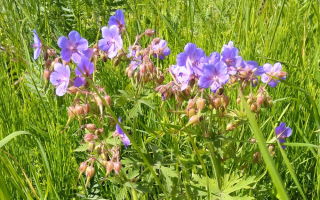Content
- 1 Description of the medicinal plant meadow geranium
- 2 Where does meadow geranium grow
- 3 Chemical composition
- 4 Medicinal properties of wild meadow geranium
- 5 Preparation and application methods
- 6 Application in traditional medicine
- 7 Contraindications to the use of meadow geranium
- 8 Collection and procurement
- 9 Conclusion
Pigeon blossom, meadow geranium or crane is a popular herb in folk medicine. The plant has a whole range of beneficial properties. The grass is also called the roadside needle, Egorov's spear and the mother liquor. The medicinal properties of meadow geranium and contraindications have been known since the 16th century. Zhuravelnik has not lost its popularity and is successfully used for the treatment of various pathologies.
Description of the medicinal plant meadow geranium
The herbaceous perennial has a creeping rhizome and a developed ground part, which reaches a height of 80 cm. The lower feathery leaves of meadow geranium grow on long petioles. The lower leaf plates are short.
The stems of the plant are covered with fluffy hairs. The flowers of the crane are purple-blue and are arranged in small inflorescences. Decorative species are distinguished by multi-colored and double flowers.
There are several options for the name of meadow geranium:
- geranium;
- gastric herb;
- bone breaker;
- joint;
- leafy grass;
- pigeon color.
On the basis of meadow geranium, crops such as Purple Birds, Focus Pokus, Splish Splash, Pearl Gost, Laura were bred.
Where does meadow geranium grow
The grass can be found in clearings, forest edges (coniferous and deciduous) with moderate humidity. The crane is distributed in the following territories:
- Siberia;
- Europe;
- Middle Asia.
When meadow geranium blooms
The crane is a honey plant. Meadow geranium bloom is observed for two months in May and June. It is a medicinal plant that is used to treat and prevent various diseases.
Chemical composition
Zhuravelnik has a rich composition. Geranium (meadow) roots contain:
- carbohydrates such as starch;
- carotene;
- tannins;
- triterpene saponins;
- ascorbic acid;
- catechins;
- flavonoids;
- phenolcarboxylic acids.
The aerial part of the crane includes:
- fructose;
- glucose;
- raffinose;
- alkaloids;
- saponins;
- vitamin K;
- carotene;
- flavonoids;
- tannins;
- anthocyanins;
- minerals such as manganese, iron, zinc and nickel.
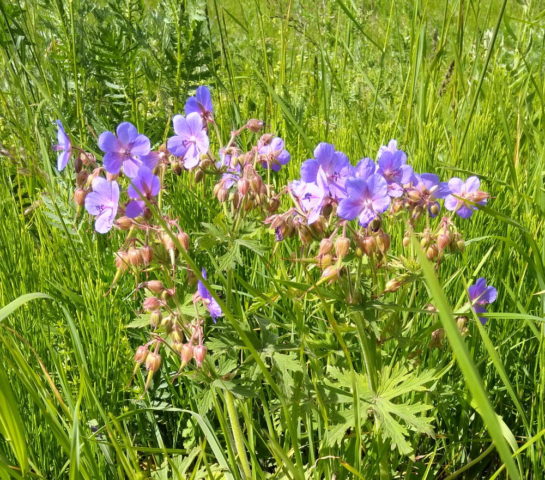
Medicinal properties of wild meadow geranium
In folk medicine, the plant began to be actively used in the second half of the 16th century. Crane has the following beneficial properties:
- astringent;
- disinfectant;
- antibacterial;
- anti-inflammatory;
- hemostatic;
- antitoxic;
- wound healing;
- calming;
- antipruritic;
- pain reliever.
The plant promotes the dissolution of salts, which is especially important for the treatment of urolithiasis and gout. Internal reception of funds from meadow geranium is prescribed for the following pathologies:
- malignant diseases;
- bone fractures;
- ARVI;
- fever;
- gastritis and enteritis, food poisoning, dysentery;
- profuse spotting during critical days;
- rheumatism;
- diseases of the heart and blood vessels.
External use of products made from a crane is advisable in the following cases:
- purulent wounds;
- abscesses;
- ulcers;
- rheumatic pains;
- anal or genital fistulas;
- sore throat or inflammation of the mucous membranes in the mouth;
- hair loss.
Meadow geranium raw materials are used in the pharmaceutical industry in the manufacture of medications.
Preparation and application methods
For treatment and prevention, various dosage forms of drugs from the crane can be used. Their effectiveness depends on the observance of the required proportions.
Tincture
The tool is prepared from the leaves and rhizomes of the plant, which should be pre-crushed. Raw materials (100 g) are poured with alcohol or vodka (500 ml). The vessel is closed and placed in a dark and cool place for two weeks. Filter the tincture before use. Take 30 drops of the drug three times a day daily. The liquid is dissolved in a third of a glass of water.
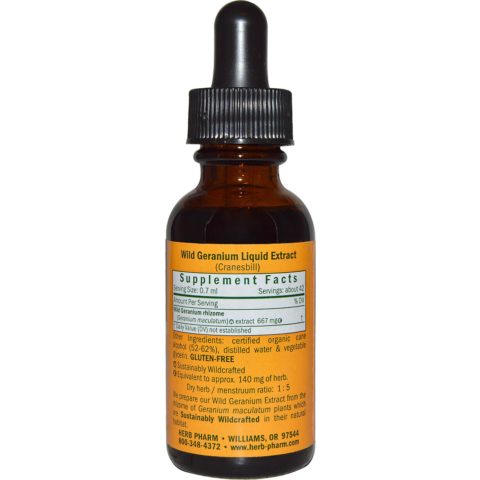
Infusion
The dosage form is used for the following pathologies:
- insomnia;
- bleeding;
- toothache.
To prepare the product, you need to pour two tablespoons of raw materials with two glasses of boiled water (cold). The composition is insisted for eight hours. Strain before use.
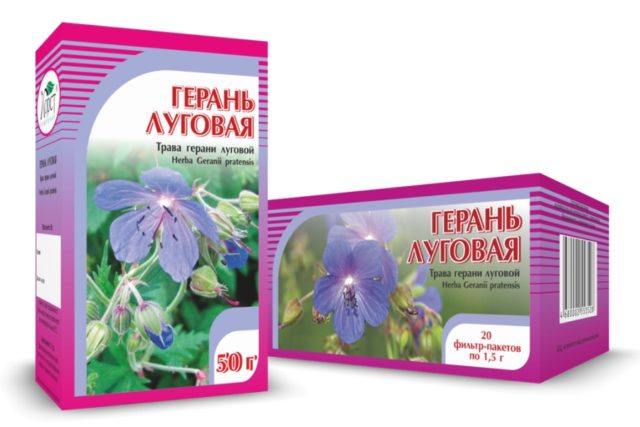
Decoction
An aqueous solution is prescribed for fever, epilepsy, rheumatism, diarrhea. Pour a tablespoon of raw materials (herbs) with a glass of boiling water. The composition is simmered over low heat for five minutes. Then the product is cooled and filtered. Before use, add clean water to the original volume.
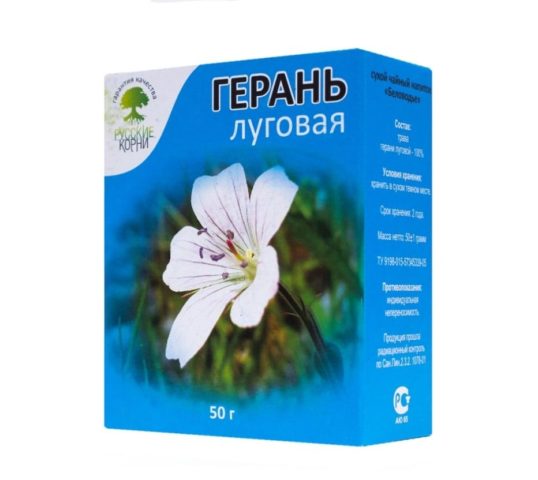
Application in traditional medicine
Various medicinal products are made from meadow geranium. Their advantage lies in the possibility of external and internal use.
Sore throat treatment
Respiratory disease is accompanied by severe pain syndrome due to damage to the palatine tonsils. Angina requires the mandatory prescription of antibacterial drugs. Lack of adequate treatment can cause the spread of the inflammatory process to the kidneys, heart and joints.
As part of complex therapy, rinses with aqueous herbal solutions are necessarily prescribed. A good effect can be expected from the use of meadow geranium infusion. Pour a tablespoon of raw materials with a glass of water and leave for several hours. Before use, the product must be warmed up in a water bath.
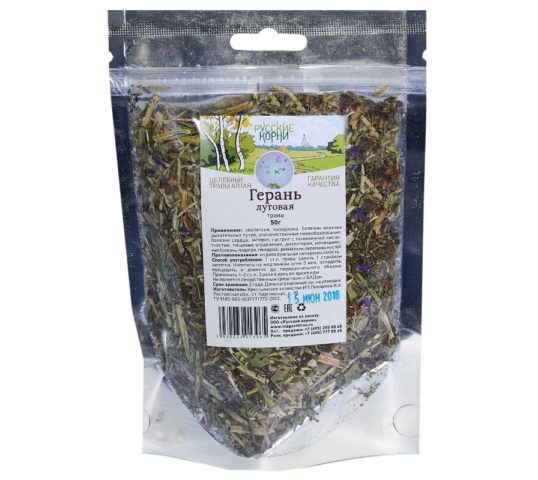
Normalization of discharge with heavy periods
Hormonal dysfunctions, inflammatory processes often lead to increased blood loss during critical days. Pathology is accompanied by a deterioration in general well-being. Lack of therapy can provoke the development of anemia.
With abundant menstruation, it is recommended to drink a decoction from the roots of meadow geranium. Three tablespoons of raw materials are poured with a glass of boiling water and simmer for five minutes over low heat. Before use, the broth is cooled and filtered. The remedy is drunk every two hours in a tablespoon.

Against hemorrhoids
To prepare a healing remedy, you will need fresh grass juice. Raw materials are crushed to the state of gruel and juice is squeezed out with gauze. The remedy is drunk 25 drops every three hours.

For insomnia
A tablespoon of crushed dry roots is poured into a glass of water, brought to a boil. The composition is tormented for ten minutes on low heat, and then insisted for an hour in a thermos. Strain the liquid before taking it.

For joint diseases
For external use, a concentrated broth is suitable. To prepare it, pour boiling water (250 ml) over four tablespoons of crane herb. The composition is tormented for five minutes on low heat, cooled and filtered. A piece of gauze is soaked in liquid, squeezed out and applied to sore spots.
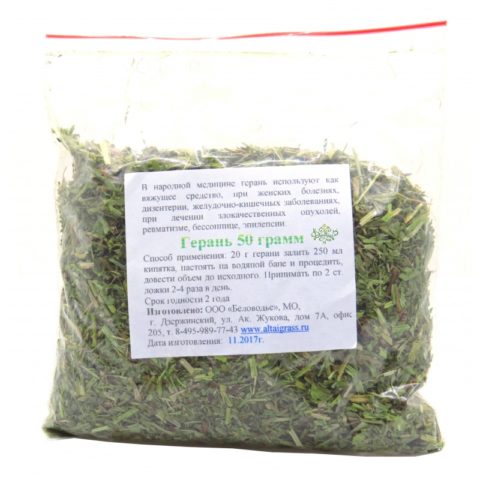
Elimination of dry face
Infusions and decoctions of meadow geranium help to refresh the complexion, giving softness in case of external use. Pour a tablespoon of dry crushed leaves with a glass of boiling water and leave for 40 minutes. The product is used after cooling and straining in the form of washing or rubbing the skin of the face.
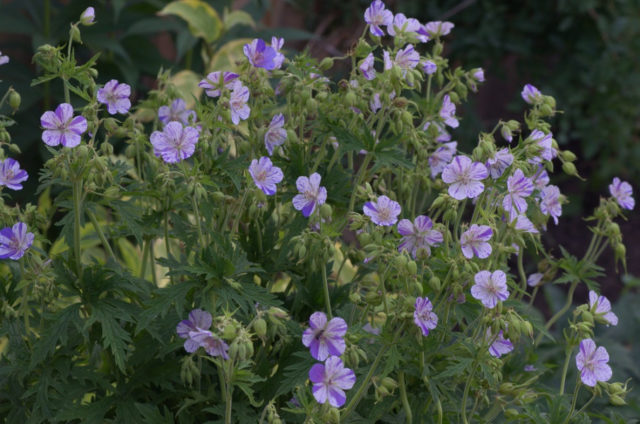
Contraindications to the use of meadow geranium
Any traditional medicine has contraindications for use. Zhuravelnik is no exception. Decoctions, infusions and juice of meadow geranium are not recommended for use in the following cases:
- increased blood viscosity;
- thrombosis and thrombophlebitis;
- constipation, intestinal atony;
- gastritis (with high acidity).
Collection and procurement
Meadow geranium, the photo and description of which are located above, belongs to the known medicinal plants. The presence of valuable properties and unique composition depends on the correct collection, procurement and storage of raw materials.
Most of the crane-based products are made from the aerial part. Meadow geranium flowers and leaves should be harvested during flowering periods. Usually, the herb is picked in the morning after the herb has dried. The presence of sunny weather is essential. These conditions guarantee the maximum safety of nutrients. The grass is dried in an electric dryer (at a temperature of 45 ° C) or in a well-ventilated area.
Crane roots are dug up in the fall, cleaned of dirt, washed and dried. Harvesting is possible both in whole and in crushed form.
Conclusion
The medicinal properties of meadow geranium and contraindications must be taken into account before using products made from a medicinal plant. Drugs are used to treat diseases of the nervous, digestive. reproductive and musculoskeletal systems. Antibacterial, anti-inflammatory effect allows you to prescribe decoctions and tinctures from the crane to eliminate diseases and skin defects.

